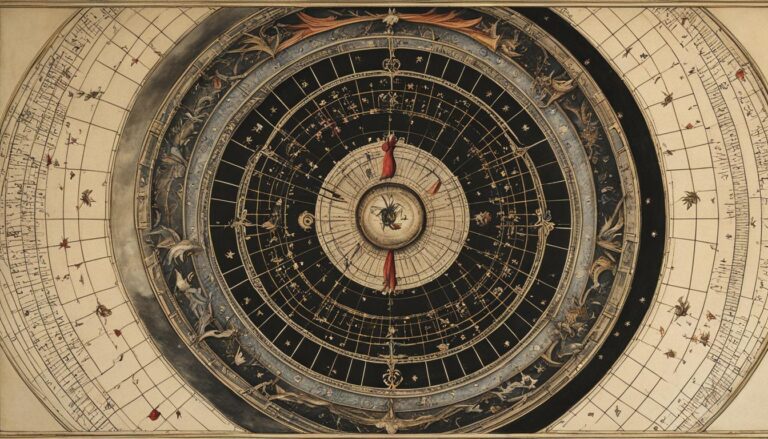What is Vedic Astrology?
Many people search for deeper meaning in the stars, wondering how celestial patterns might play a role in their lives. Vedic astrology, known as jyotish or “the science of light,” offers an ancient way of understanding our personal journeys.
This blog post will explore the cosmic insights Vedic astrology provides to help you uncover life’s mysteries and guide your path forward. Dive deep into the starry wisdom!
Key Takeaways
- Vedic astrology, also known as Jyotish, originates from ancient Vedic texts and holds significant cultural and spiritual importance in Hindu traditions.
- It differs from Western astrology by using the sidereal zodiac, unique planetary influences and aspects, and a strong emphasis on the concept of karma to provide deep insights into an individual’s life path.
- Components such as zodiac signs, nakshatras (lunar mansions), planetary periods (Dashas), and specific yogas play crucial roles in shaping an individual’s destiny according to Vedic astrology principles.
The Historical Roots of Vedic Astrology

Vedic Astrology has its roots in the ancient Vedic texts, specifically the Vedas. Over time, these texts evolved into a sophisticated system of astrological practice that holds significant cultural and spiritual significance in Hindu traditions.
The Vedas and the Origin of Vedic Astrology
The ancient scriptures known as the Vedas hold the seeds of Vedic astrology, emerging from India’s profound spiritual heritage. These texts are not just religious hymns but also a complex repository of cosmic knowledge that underscores human existence.
Immersed in this wisdom, Jyotisha or Hindu astrology unfolded over millennia, offering insights into life’s mysteries through the movements and positions of celestial bodies.
Astrologers in ancient times meticulously studied planetary patterns to discern their influence on people and events. Interwoven with spiritual concepts such as karma, these astrological interpretations helped individuals align with their life path and pursue spiritual development.
The Vedas serve as a timeless fountainhead for this sacred astronomy, guiding seekers towards enlightenment well beyond mere prediction or fortune-telling.
The Evolution from Vedic Texts to Astrological Practice
Sages of ancient India studied the stars and planets, weaving their insights into the sacred Vedas. Over time, these spiritual texts laid the groundwork for Jyotish or Vedic astrology, a practice that delves deep into an individual’s karma as influenced by celestial bodies.
This transformation from scripture to systemized knowledge marked a significant leap in how humans sought understanding of their place in the cosmos.
Astrologers meticulously charted planetary movements against the backdrop of constellations, introducing a sidereal zodiac that remains pivotal to Indian astrology even today. They crafted birth charts reflecting life paths shaped by cosmic forces—an approach profoundly different from western horoscopes based on sun signs.
Now let’s explore how this impacts one’s destiny through key differences between Vedic and Western astrology.
Key Differences Between Vedic and Western Astrology

Vedic astrology differs from Western astrology in several key ways, such as the use of the sidereal zodiac instead of the tropical zodiac, unique planetary influences and aspects, and a strong emphasis on the concept of karma.
Understanding these differences can provide valuable insights into how Vedic astrology approaches chart interpretation and predictive techniques.
Sidereal vs. Tropical Zodiac
The planets dance across the sky in a rhythmic pattern, and how we map their movements can change our perspective of astrology. The sidereal zodiac keeps its eyes on the fixed stars, anchoring signs to their celestial backdrop, which offers consistent guidance for those seeking wisdom from Vedic astrologers.
Meanwhile, Western astrology’s tropical zodiac sets its stage by the seasons of Earth, aligning signs with the equinoxes and solstices.
This stark contrast between sidereal and tropical systems might explain why someone could be an Aries under one system but a Pisces under another. By focusing on actual observed positions in the night sky rather than seasonal shifts, Vedic astrology provides insights that are distinctive because they sync with star constellations as viewed from Earth.
Astrological sign differences arise due to this fundamental divergence in tracking planetary paths through different zodiacs.
Planetary Influences and Aspects
In Vedic astrology, planetary influences and aspects play a crucial role in shaping an individual’s life. Unlike Western astrology, Vedic astrology does not consider the influence of Uranus, Neptune, or Pluto on the individual.
Each planet has its special aspects and strengths that are applied to interpret their effects on different areas of life.
The planets in Vedic astrology are directly related to energizing factors such as yoga and ayurveda. These influences guide practitioners in understanding how celestial bodies impact various aspects of life, providing valuable insights into health, relationships, career, and personal growth.
Concept of Karma in Vedic Astrology
The concept of karma in Vedic astrology lies at the core of its principles. It emphasizes that an individual’s actions, both past and present, directly shape their destiny. According to Vedic astrology, the position of the planets and stars at the time of a person’s birth reflects their karmic tendencies and influences their life experiences.
This belief is closely tied to Hindu philosophy, which holds that every action has a consequence – whether positive or negative – and individuals are accountable for these repercussions throughout their lifetimes.
Vedic astrology intertwines spirituality with astrological interpretations, offering insight into how one’s karmic patterns can manifest within specific time frames. The emphasis on karma provides a personalized approach to understanding astrological influences by delving deeper into an individual’s spiritual journey.
Understanding the Components of Vedic Astrology
Vedic Astrology involves the study of zodiac signs, natal charts, and planetary periods known as Dashas. Nakshatras, or lunar mansions, play a crucial role in determining astrological influences on individuals.
Zodiac Signs and Vedic Chart
The Vedic chart, known as the Janma Kundali, maps out the planetary positions at the time of an individual’s birth and forms the basis for understanding one’s destiny. Each zodiac sign has specific qualities associated with it, representing different aspects of life such as personality, career, health, and relationships.
In Vedic astrology, these signs are divided into 12 houses that influence different areas of life. The rising sign or Ascendant is considered a crucial element in interpreting one’s true nature and life path.
The positioning of planets in specific zodiac signs further influences an individual’s traits and experiences throughout their lifetime. For instance, a strong placement of Mars can signify assertiveness and courage while also indicating potential conflicts or accidents related to its ruling house in the chart.
Nakshatras: The Lunar Mansions
Nakshatras, often referred to as the Lunar Mansions, are an integral part of Vedic astrology. With 27 nakshatras and each divided into four parts called pada, they form a total of 108 nakshatra-pada in the zodiac.
The Moon spends approximately one day in each nakshatra, influencing various aspects of life based on its position. These lunar mansions are connected to specific stars or groups of stars known as asterisms within their sectors, emphasizing their celestial significance.
The Nakshatras play a crucial role in Vedic astrology and are believed to hold substantial influence over individual destinies and life paths. Understanding these lunar mansions is essential for delving deeper into the components and interpretations within Vedic astrology.
Planetary Periods (Dashas) and their Significance
Each planetary period, or Dasha, in Vedic Astrology has a significant impact on various aspects of life. Governed by one of the nine planets, each Dasha holds sway for a specific duration according to its individual influence and role.
The unique Mahadasha system predicts major periods under the rule of different planets, influencing events and experiences profoundly during their reign. Within the natal chart, the placement of each planet determines the length and intensity of its influence, actively shaping outcomes according to combinations with signs and houses.
The effects brought about by planetary periods are distinctively tied to their specific placements within charts or combinations with houses and signs. As they unfold over time, these celestial influences give rise to both favorable and unfavorable circumstances based on their calculated positions.
Different calculation methodologies define how planetary dashas manifest within Vedic Astrology’s rich tapestry – each method contributes unique insights into astrology’s predictive power.
Exploring Specific Yogas in Vedic Astrology
Explore the significance of Dhriti Yoga and its influence on personal growth and self-understanding in Vedic Astrology. Find out how this specific yoga can provide valuable insights into your life path and potential.
Read More!
Understanding Dhriti Yoga and its Influence
Dhriti Yoga, a significant concept in Vedic astrology, is formed when Jupiter occupies the Lagna or Ascendant in a person’s birth chart. This powerful combination can significantly impact an individual’s wealth, health, and prosperity.
It provides valuable insights into how celestial bodies influence human life and helps determine specific remedies needed to address its effects. Dhriti Yoga is among the 27 unique Yogas based on the twenty-seven constellations in Vedic astrology, each representing distinct celestial patterns of influence.
This special combination plays a crucial role in shaping an individual’s life trajectory and well-being. Understanding Dhriti Yoga offers essential insight into one’s overall quality of life and potential remedies required for balance and harmony.
The Relevance of Vedic Astrology Today
Vedic astrology continues to be relevant today as a tool for personal growth and self-understanding. Its predictive power also plays a significant role in helping individuals make important life decisions.
Personal Growth and Self-Understanding
Vedic astrology is deeply intertwined with personal growth and self-understanding. By studying the cosmic influences on our lives, we gain valuable insight into our life’s journey and purpose.
Through Jyotish astrology, individuals can explore their karmic path and better understand the challenges they face. This knowledge allows for deep self-reflection, fostering spiritual and personal growth.
Personalized Vedic charts provide a roadmap for navigating life’s complexities, offering clarity on one’s strengths and areas for improvement.
Predictive Power and Life Decisions
Vedic astrology wields remarkable predictive power, offering insights into various life decisions and events. By evaluating the natal horoscope in relation to specific moments and subjects, Jyotisha, a form of Vedic astrology, effectively provides guidance for personal growth and decision-making.
Understanding the influence of planets as they shape one’s horoscope is particularly valuable when making choices about love, marriage, career, and other significant life aspects.
The belief that stars have predictive power is at the core of Vedic astrology. This ancient practice has stood the test of time by offering valid predictions while considering planetary influences on individuals’ lives.
Conclusion
In conclusion, Vedic astrology, also known as Jyotish, offers deep insights into individual destinies through the placement of planets and houses in horoscope calculations. Emphasizing practicality and efficiency, this ancient practice provides a solid framework for understanding life’s complexities.
Have you considered exploring further resources to delve into this intriguing science? By applying the knowledge gained from Vedic astrology, one can navigate life’s challenges and make informed decisions with confidence.
The significance of this traditional Hindu system lies in its potential impact on personal growth and self-understanding. So have faith in the wisdom stemming from Vedic astrology as it unravels the mysteries of existence.
To delve deeper into how Dhriti Yoga can influence your life, please visit Understanding Dhriti Yoga in Vedic Astrology.
FAQs
1. What is Vedic Astrology?
Vedic Astrology, also known as Jyotiṣa, is an ancient Indian system that uses the positions of planets and stars, including nakṣatras and rashis, to predict life events.
2. How does Vedic Astrology differ from Western astrology?
Unlike Western astrology which focuses on the solar system and zodiacal signs based on seasons, Vedic Astrology uses sidereal zodiacs tracking planetary movements against fixed stars to uncover deep insights into one’s destiny.
3. What are some key components in a Vedic Astrology chart?
Key components include the five elements (earth, water, fire, air, ether), bhāvas (houses), planetary periods (daśās), ecliptic plane details specific to lunar-based nakṣatras for profound readings.
4. Can Vedic Astrologers use mantras during their practice?
Yes! Indian astrologers may incorporate sacred sounds like “Aum” or suggest specific mantras tied with Hindu texts such as Rigveda for spiritual growth towards moksha or liberation.
5. Is there a connection between festivals like Navaratri and Vedic astrology?
Certainly! Festivals like Vijayadashmi celebrating Dussehra originate from astronomical alignments noted in vedic charts symbolizing spiritual victories embodied by gods and goddesses observed in Vaishnava traditions.
6. Does the study of natal charts correspond with yogic practices within Hinduism?
Indeed it does; janam kundali analysis aligns with yogic paths promoting dhyana for mental focus while acknowledging concepts such as karma found within Krishna consciousness leading seekers towards self-realization.







